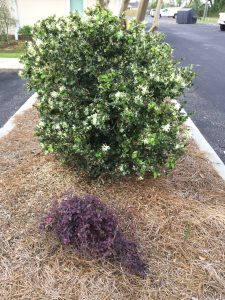
by Mark Tancig | Feb 27, 2025
It’s almost March and it’s not just March Madness that’s about to happen, but No Mow March. This year will be the third year that the Horticulture Extension Agents of the UF/IFAS Northwest District have promoted No Mow March. The No Mow March campaign encourages those with lawns to leave some late winter/early spring wildflowers to benefit wildlife.
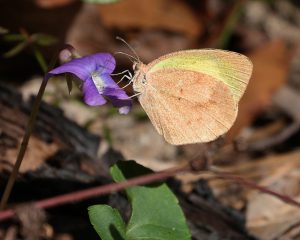
A Barred Yellow butterfly visit a violet, one of our late winter wildflowers that can be found in your lawn. Credit: Steve Coleman.
If you don’t think you’re ready to skip mowing the whole lawn for the whole month of March, then maybe you could try a small piece and hold off as long as you can. The point is to get you thinking of how your lawn, usually not considered an inviting place for most wildlife, can actually provide valuable ecosystem services. Many pollinator species in our area are emerging from their winter break and looking for food as we move into March. Plants in your lawn that are typically considered “weeds” are perfect pollinator feeders at a time when other landscape plants have yet to begin flowering. Providing extra floral resources can be especially useful in more developed areas where well-kept landscapes reduce what’s available for pollinators. Since the health and abundance of insect pollinators contribute to the ability of higher organisms, especially birds, if there’s more insects, then there’s more food for the birds, too!
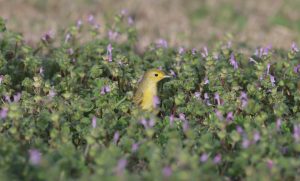
While you’re not mowing, try observing the wild plants and animals that visit your lawn. You can get help identifying them by using apps like iNaturalist or Seek. You could also spend some time ripping out part of the lawn and planting a new flower bed of native plants. Or you can focus on identifying any invasive plant species in your landscape and work on removing them.
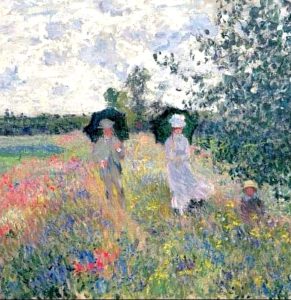
Instead of mowing, take a walk in the wildflowers during March. Credit: Taking a Walk near Argenteuil by Claude Monet.
The Horticulture Extension Agents of the UF/IFAS Extension Northwest District have put together a No Mow March website with more information, including a list of related workshops and classes, as well as a pledge you can take to affirm your choice to participate.

by Mark Tancig | Jan 16, 2025

Have a Happy, Green 2025!
This is the time of year where we often pledge to change and/or improve something about ourselves, but why not have a garden resolution, too. If you’d like a garden resolution or you’ve run out of personal resolution ideas (and you’re a gardener), then I have a couple of suggestions to help you garden with purpose this year.
Try to Accept more Imperfections in Your Landscape
Just like maybe we shouldn’t be so hard on ourselves or family members, we should also give our landscapes some grace. It’s hard to be perfect, and most landscapes have some minor, mostly aesthetic, imperfections, but that’s okay. Consider these landscape imperfections signs of character and what make it unique. Try to focus on the positive qualities of the overall landscape and not fixate on minor insect damage or a weed or two in the lawn. You may find that many of these issues clear themselves up on their own and your anxiety, worry, and efforts were not needed.
Reduce Pesticide Use
Somewhat dovetailing with accepting more imperfections, try and pledge to use less pesticides in your landscape. Many pesticides are applied in an attempt to fix minor landscape problems that often go away on their own. Based on numbers collected by various agencies, gardeners apply literal tons of pesticides to their ornamental landscapes. These products have environmental impacts and are often not fixing the problem, due to misdiagnosis, wrong timing of application, and/or other improper usage.
The UF/IFAS Florida-Friendly Landscaping™ Program has more information on how to manage landscape pests responsibly.
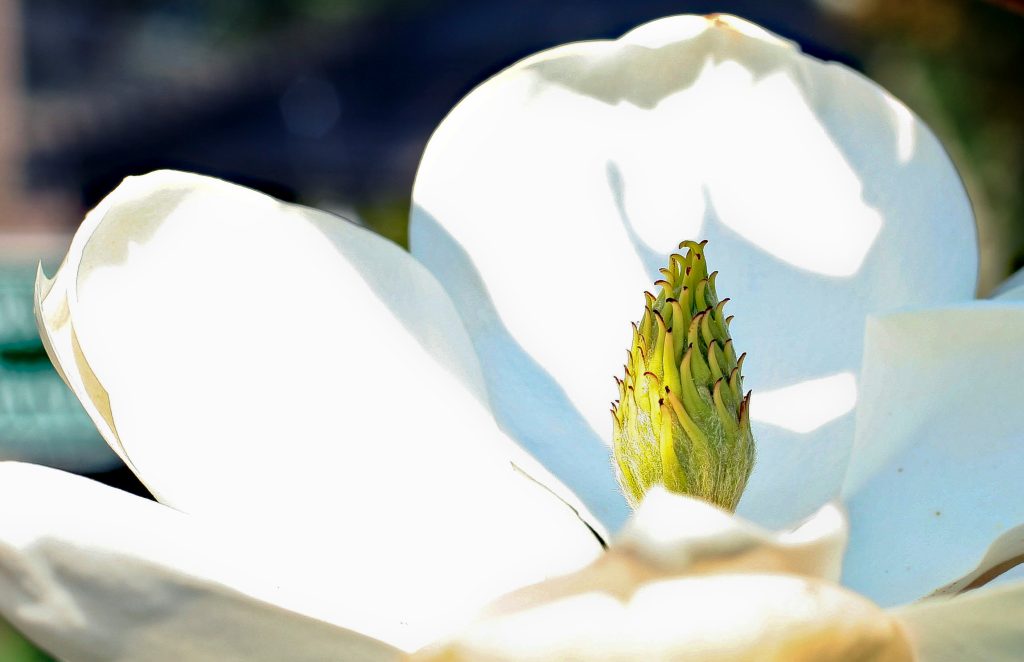
The native southern magnolia (Magnolia grandiflora) is a great native tree to plant in your landscape. Credit: Laura Ciociola.
Plant More Native Species
When thinking of new plantings or browsing the nursery, consider selecting native species for your landscape. Native species are more adapted to our native insects, diseases, soil conditions and climactic patterns. Native plants aren’t necessarily easier to grow – you still need to take care to get them well established – but they tend to be better able to handle the environmental stressors of our area. Additionally, native plants are most likely to benefit native wildlife species.
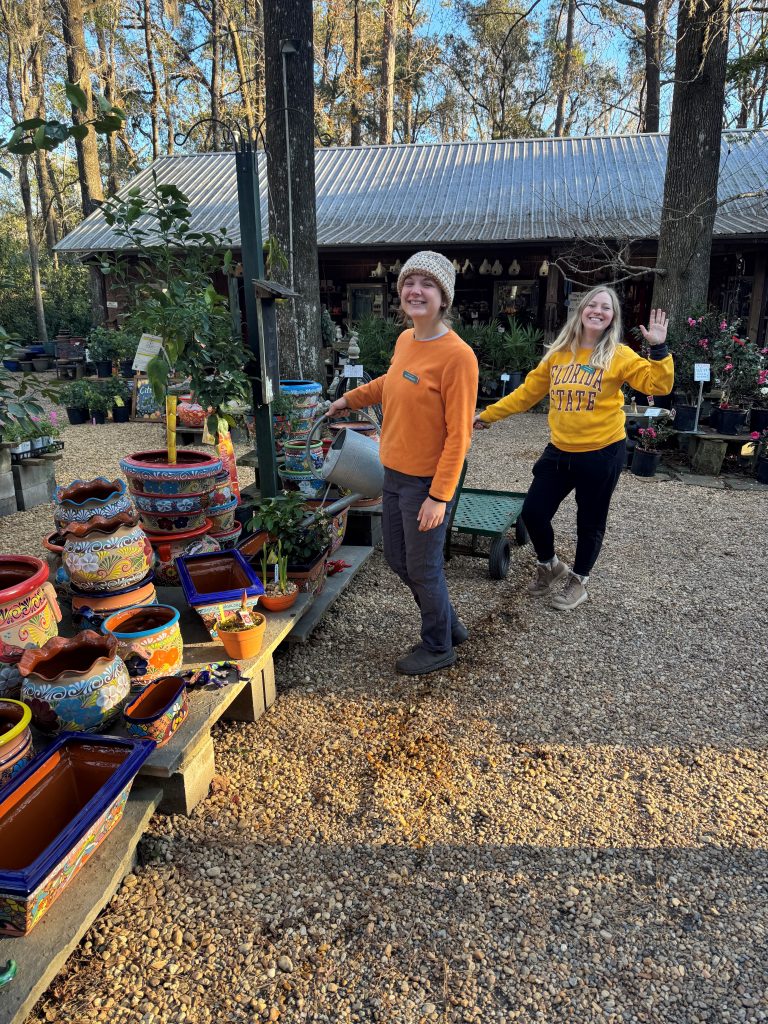
Local nurseries typically only offer plants well suited to your area and are your neighbors! Credit: Native Nurseries
Shop at Local Nurseries
When looking for those native plant species, try to support your local nursery businesses. Local nurseries tend to only carry the plants that are best suited to the area, and they’re your neighbors, too. To help find both native plant species and local nurseries, there is an association of Florida native plant nurseries (the Florida Association of Native Nurseries – FANN) that has a wonderful online search tool to find the perfect plant from the closest nursery.
Of course, don’t forget to utilize your local extension office if you decide to take on these resolutions. Whether it be help confirming that it is just a minor imperfection, help diagnosing a disease or insect problem, selecting native plant species, and or finding a local plant nursery, your local extension office can lead you in the right direction. UF/IFAS Extension’s Gardening Solutions webpage and Florida-Friendly Landscaping™ Program site also have plenty of online resources to help you have another successful and sustainable gardening year.
Happy New Year and Happy Gardening!
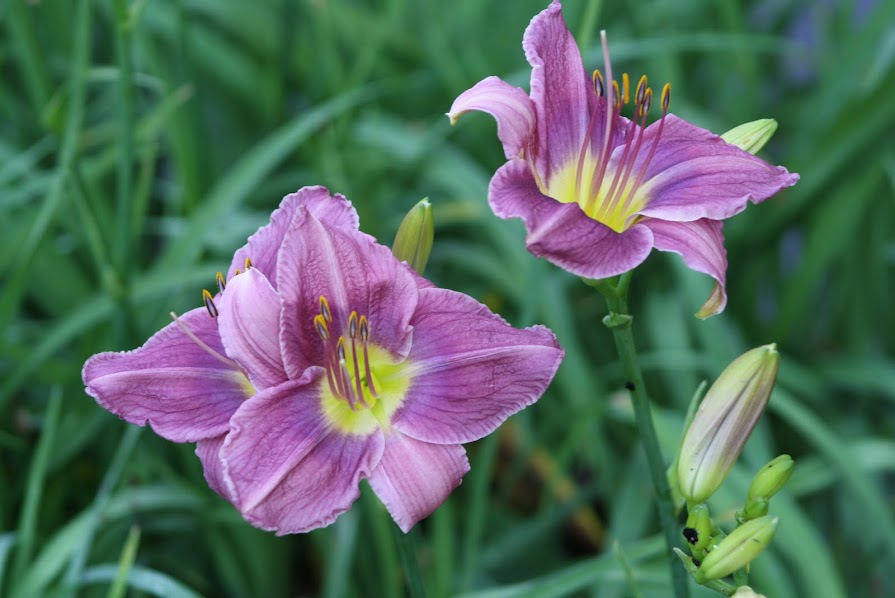
by Julie McConnell | Dec 18, 2024
Before my career in Extension, I spent ten years selling plants. I worked at a 40-acre nursery that was filled with thousands of plants. The selection was enormous and it was an eye-opening experience, even for a horticulturalist, to see how many different types of the same plant species were on the market. I learned quickly that if someone came in and said, “I need a daylily,” “I need a hydrangea,” or “I need a loropetalum” there were a lot more questions that needed to be asked to help them properly!
Plant breeders in ornamental horticulture spend their careers selecting plants for winning features that gardeners will line up to buy. Examples of traits include flower color, repeat flowering, mature size, disease resistance, cold hardiness, sun/shade tolerance, and foliage color. There are a lot of steps between recognizing what might be a superstar and availability in your local garden center, but let’s just jump to the part where they are in the garden center.
When shopping for plants, always look for the full name of the plant, preferably the botanical name which will include genus and species in Latin. Some plants are grown from seed and may have some variation in features. For example, a live oak grown from an acorn will be named with only genus and species, Quercus virginiana. The mature growth habit will have a wider range than one that was cultivated from a parent plant with known features. The species could be smaller than average, larger than average, an interesting branching feature, etc. Think of your own family, kids from the same parents may have different eye color, hair color, and height but they are all human children!
A cultivated plant is grown from cuttings or similar propagation methods that create a genetic clone of the originally selected plant. It is considered a cultivar if it will not grow true from seed and needs human intervention to result in the identical characteristics as the parent plant. The botanical name of a cultivated plant will follow the italicized species and is written/typed in single quotes. Note, since many plants are trademarked, there may be a botanical name that isn’t very flashy followed by a similar name, with some marketing flair. Let’s look at a couple of examples:
As you can see, just asking for a Loropetalum can result in vastly different plants!
Relying on common names only can also lead to an unintentional purchase. The same common name may be used for two very different plants. Another issue is that closely related species may have different places of origin and if you are trying to use only Florida native plants that could impact your design plans. Here are a couple of examples:
The takeaway message is always look for botanical names and do a little homework when purchasing plants. Ensure the plant you are looking at has the features that match your landscape needs!
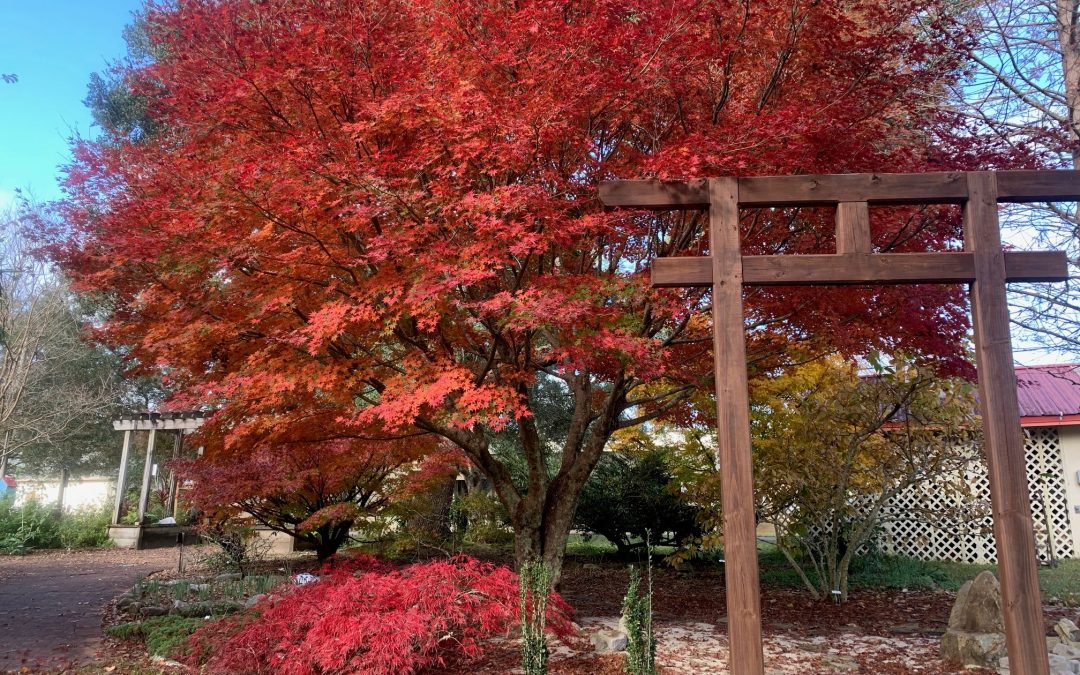
by Beth Bolles | Dec 13, 2024
When looking for a small tree that provides a visual impact in the landscape, nothing beats a Japanese maple.
In North Florida, we have landscapes with some suitable conditions for growing a Japanese maple but these trees are not for every site. Japanese Maple plants prefer some shade, especially in the afternoon, and protection from winds. If you have a high tree canopy that allows for filtered sun throughout the day, many cultivars will grow well with this light. Soils should be moist but well drained with good organic matter. Areas with higher pH soils such as home foundations or around concrete patios usually show plants with poorer growth and nutrient issues.
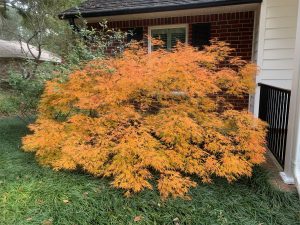
This specimen is suited to its spot with acid soil with a high Live oak tree canopy. The fall color is beautiful. Photo by Beth Bolles, UF IFAS Extension Escambia County.
Many people love the leaf color of Japanese maples, either burgundy leaf forms or selections with beautiful fall color. The palmate leaf shape also adds interest, along with varying degrees of coarse to finer textures.
My favorite characteristic of the Japanese maple is the growth form. Trees often have a layered appearance with branches extending outward, making a beautiful small canopy. Many selections have smooth bark but one cultivar, the Pine bark maple, has plated bark that looks like a pine tree.

Pine bark Japanese maple form and fall leaf color. Photo by Beth Bolles, UF IFAS Extension Escambia County.
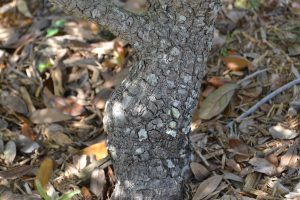
Interesting bark of the Pine bark maple. Photo by Beth Bolles, UF IFAS Extension Escambia County.
Although the growth rate is slow to moderate, be sure to research the plant size of the cultivar you want. There are small tree forms that will reach an average of 20 feet and plants that only grow about 5 feet in twenty years. Our cool season is the best time to plant a Japanese maple if your landscape is suited for this tree.
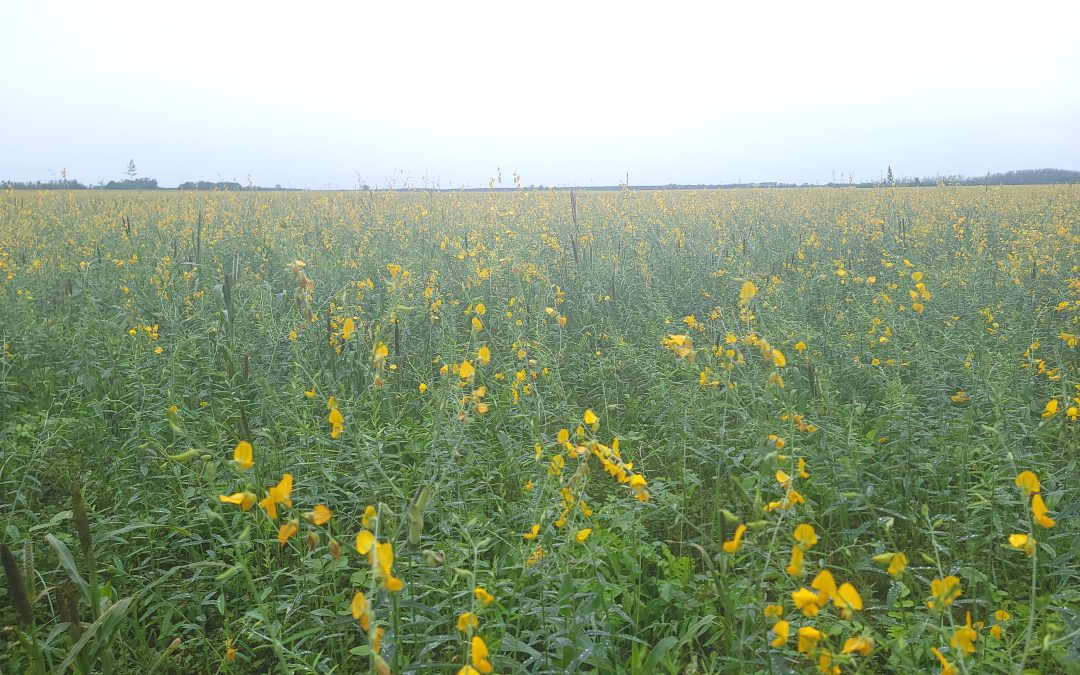
by Joshua Criss | Nov 21, 2024
A Sea of Yellow
You do not often see a sea of yellow flowers on what was recently a field of row crops in North Florida. In this instance, the culprit is a cover crop called sunn hemp (Crotalaria juncea). Cover cropping, or green manure as it is sometimes known, is not a new concept. It is a great method for improving soil quality, adding organic matter, augmenting nitrogen supply, supporting pollinators when resources begin to wane, and combating nematodes. Incorporating this sustainable agriculture practice into home vegetable gardens is an excellent method to build long-term viability and production.
Many plants may be used in this capacity, but this article will focus on sunn hemp. This annual is an herbaceous, short-day flowering plant in the Lamiaceae or legume family. Its erect stems produce a great deal of biomass and, as a legume, will augment nitrogen stores within your soil profile. As if that wasn’t enough to sell you, this plant is also known to suppress nematode populations. Native to India and Pakistan, where sunn hemp is grown for fiber, this plant grows well in tropical and temperate environments. It will thrive in even sub-par conditions and requires little fertilizer input.
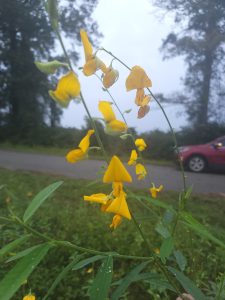
UF/IFAS Photo: Josh Criss
Seed Time
Seed this plant once your summer gardens have begun to wane. The shorter day length will keep the plant confined to about 3-4 feet while still allowing it to flower. It may also be planted earlier in the year to maximize below-ground biomass and add organic matter. In this scenario, the plant will likely grow to 7 feet tall with a closed canopy within 10 weeks.
Sunn hemp requires little fertilization as it is a legume, a plant family known to fix nitrogen from the atmosphere. This same mechanism is one of the features of this plant as a cover or green manure crop, as it can add up to 320 pounds of nitrogen per acre back to the soil when planted en masse.
Seeding rates within a home garden are much smaller. A farmer may plant 30-50 pounds of seed, which is not practical in small-scale growing. Instead, aim to cover the garden area through broadcasting seed, as a denser planting will reduce the later branching of this plant. Ensure you have 8-12 weeks of warm, frost-free weather, and terminate them prior to reaching the full bloom stage. Doing so will provide your gardens with the same benefits seen in farm fields utilizing this sustainable practice.
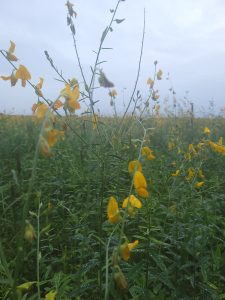
UF/IFAS Photo: Josh Criss
To Sum it Up
Sunn hemp is an excellent plant for your gardens before your fall greens. The biomass it produces and the nitrogen it recovers make it very attractive to farmers and should raise eyebrows even in the home garden. The trick is learning to manage this plant within your crop rotation. For more information on soil management refer to these IFAS documents, or contact your local extension agent for additional information on this and any topic regarding your gardens and more.
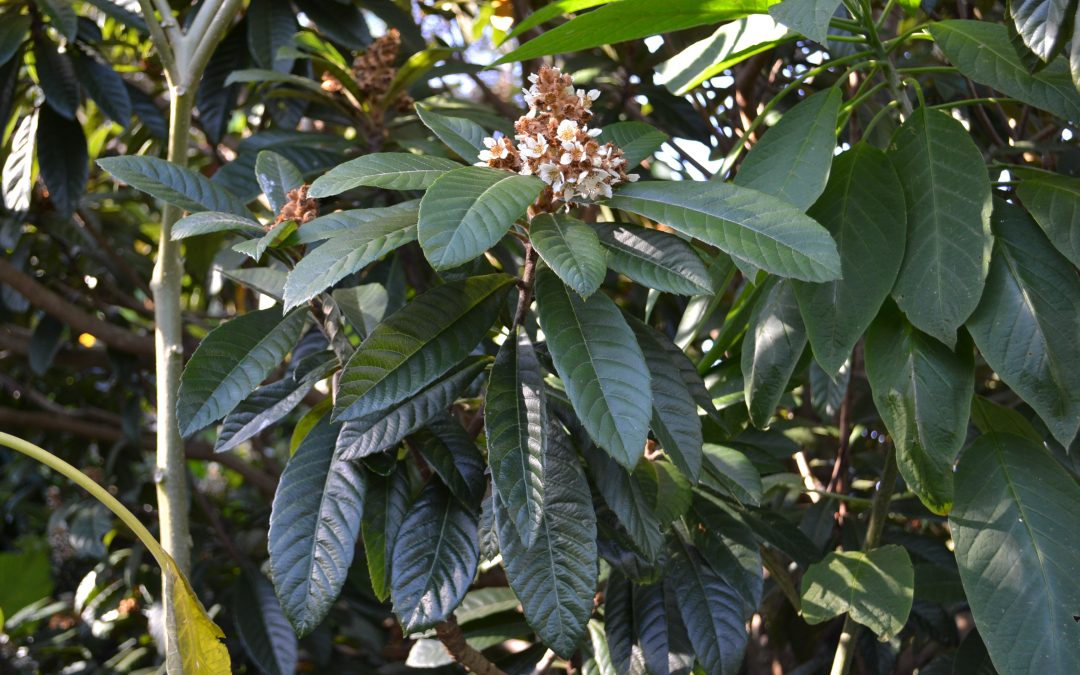
by Beth Bolles | Nov 13, 2024
Although not native to Florida, the Loquat or Japanese plum is adapted to North Florida conditions. Unlike its relatives, apple, peach, and pear, the loquat is an evergreen tree providing a tropical look with attractive dark green leaves.
Flowers appear in Fall and are pollinated by many insects. Orange fruits are ready for harvest in spring if temperatures have not been too cold.
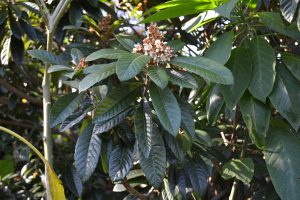
Bees will visit loquat flowers in the fall. Photo by Beth Bolles, UF IFAS Extension Escambia County.
Loquat trees can reach 20 to 25 feet in height with a good spread. Seedling trees will produce fruit but improved flavors are available with different cultivars.
One of the loquats in the Escambia County Demonstration garden was damaged by a hard freeze and succumbed to a secondary bark beetle attack the following spring. The 2nd tree is thriving as a key feature in the tropical garden. The downside to the location of our tree is that is surrounded by informal walkways that can get messy from fruit that falls in the spring. This may be a consideration when you install your own loquat tree.
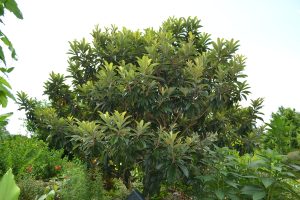
Loquat at Escambia Extension. Photo by Beth Bolles, UF IFAS Extension Escambia County










